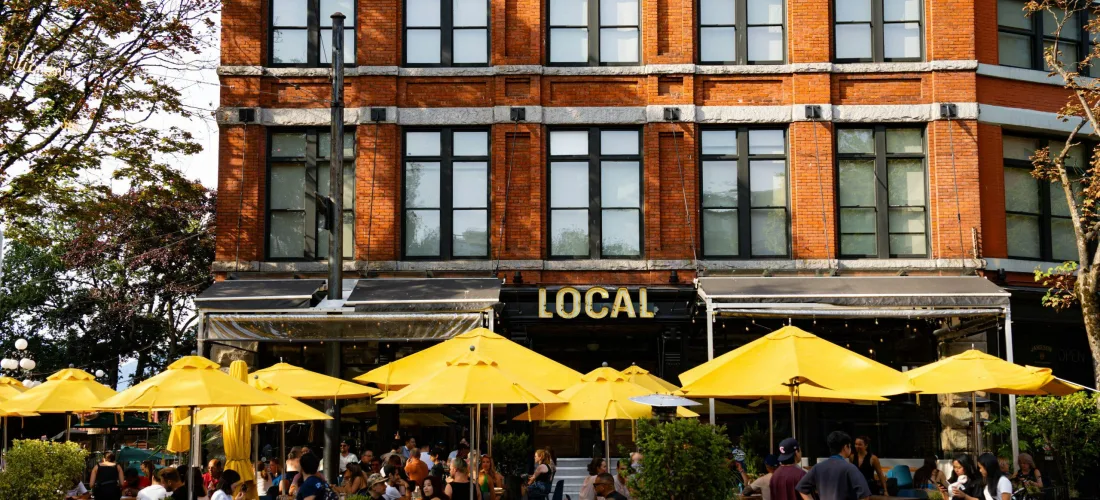
CityTalk Live Webinar
5 Key Takeaways
1. Localism and Community Density are the Cornerstones of Resilience
Olivier Legault of Rues Principales highlighted that the communities which emerged strongest from past crises—such as the COVID-19 pandemic—were those with a strong local customer base. He cautioned that trends like “buy local” often surge in response to crises but tend to fade without sustained policy support. Legault advocated for long-term strategies centered on densifying town centres, enabling municipalities to exert greater control over real estate for the public good. This includes preserving cultural vibrancy, fostering affordability, and resisting gentrification. He argued that a truly resilient downtown must go beyond short-term stimulus efforts and focus on building “carbon sober, complete neighbourhoods” rooted in place, identity, and sustainable municipal revenue. Property tax optimization could play a key role in this approach—helping cities generate revenue efficiently while promoting equitable urban development.
2. Hyperlocal Consumer Shifts Are Reshaping Small Business Strategies
Nancy Tissington, from Uptown Saint John BIA, emphasized how local businesses are navigating economic uncertainty by embracing hyper-localism, Canadian pride, and community-driven strategies. In response to tariff-related disruptions and global trade instability, she noted a surge in patriotic consumer behavior, with shoppers increasingly scrutinizing product origins. This shift is encouraging businesses to prioritize Canadian-made goods, fostering supply chain resilience and economic independence. Nancy described small businesses as “the purest form of economic development,” underscoring their central role in shaping local identity, sustaining jobs, and anchoring main street vitality. Grassroots efforts such as Uptown Saint John’s “LoveLocal” campaign, she argued, are not just symbolic—they actively reinforce the cultural and economic value of main streets. By investing in both community identity and practical procurement shifts, Uptown Saint John is positioning itself to weather uncertainty with creativity and cohesion. Nancy’s message was clear: main streets succeed when they root economic strategy in local values, visibility, and shared sense of place.
3. Cross-Border Communities Face Unique Economic and Social Friction
Nicholas Luck, of Sault Downtown Association, provided insights on the unique challenges faced by border towns during times of economic uncertainty. Nicholas explained that 50% of the steel produced in Sault Ste. Marie is exported to the U.S., and the imposed tariffs could have significant downstream effects on local businesses and jobs. Additionally, he noted the decline in bridge crossings and reduced U.S. tourists, which has further compounded the economic stress on main street businesses. Nicholas also shared ideas on how to mitigate these challenges, particularly through business-to-business collaborations such as shared purchasing power among local retailers and restaurants. This approach would help reduce costs by leveraging bulk buying with Canadian suppliers, thus lessening the financial strain of tariff-driven price increases. Nicholas emphasized the need for local supply chain development to build resilience and prepare for future economic disruptions, encouraging a shift towards more collaborative, community-based business strategies in response to ongoing crises.
4. Zoning and Planning Are Critical Levers for Main Street Revitalization
Rylan Graham, Assistant Professor at UNBC’s School of Planning and Sustainability, focused on the ongoing challenges and opportunities facing downtowns—particularly in smaller and mid-sized cities. He discussed how suburbanization and the impacts of the pandemic have long undermined the vitality of urban centers, placing additional strain on already vulnerable main streets. Rylan identified zoning reforms and mixed-use development as crucial tools for revitalization, especially through increased housing density. By introducing more residential options in downtown areas, cities can boost foot traffic, support local businesses, and foster a stronger sense of community. He also emphasized the importance of creatively reimagining vacant spaces—such as converting them into shared workspaces or pop-up retail—to reduce operating costs for small businesses. Lastly, Rylan stressed the need for municipalities to be more intentional in leveraging zoning regulations to enable vibrant, multi-use spaces that attract both residents and businesses.
5. Data Must Catch Up with the Local Economy
The launch of Main Street Canada by the Canadian Urban Institute aims to shift the national economic lens from sectors to places. As Mary W. Rowe explained, while economic indicators typically focus on broad sectors, local businesses experience those impacts through their neighborhood storefronts. The newly introduced Tariff Impact Tracker offers insight at the regional level but is still evolving to provide main-street scale analysis. Panellists agreed that more local, real-time data is essential to inform effective policy and targeted investment. With small and medium-sized enterprises employing a significant portion of the Canadian workforce, investing in local-scale metrics is a critical step toward building economic resilience from the ground up. Granular, place-based data is essential for tracking the health of main streets—and informing smart investments.